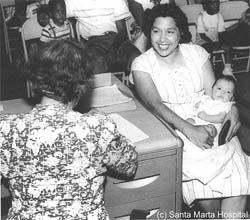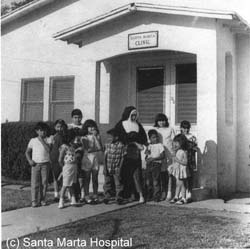
 |
Our History |
 |
A Community of Challenge and Promise Sir Daniel J. Donohue: Santa Marta's Best Friend The Gala That Built The Hospital - President-elect Richard Nixon The Sisters of Carondelet |
 |
Los Angeles, however, was originally a Mexican town, and Hispanics have always lived in East Los Angeles. The 1920s brought relative prosperity to the area. Whittier Blvd was paved while electric car lines connected East Los Angeles with downtown and, by the 1930s, with Orange County. Mobility meant economic growth. Large companies set up operations in the area, while Mexican-owned businesses prospered along Brooklyn and First. In 1939, the Catholic Archdiocese announced plans to build "a national shrine of Our Lady of Guadalupe" on Third St., pattered after the Shrine in Mexico City. Meanwhile, the community’s vibrant social and religious life was reflected in its festivities, church events and Spanish language cinema.
During the 1940s, thousands of East Los Angeles residents served in World War II. The decade was also marked by the rise in gangs in the barrio including "Zoot suiters." As the Civil Rights movement gathered momentum in the 1950s and ‘60s, racial tensions increased and erupted in massive demonstrations in the late 1960s and early 1970s.
Today, statistics continue to reveal a community to challenge and promise. More than 40% of East Los Angeles residents are foreign-born with a large number unable to speak or write English. The area’s income and education levels are below the national average. With 8,000 hard-core gang members in East Los Angeles, violence, murder, and drug arrests are a reality.
But there is also good news. There are two colleges, East Los Angeles Community and Cal State Los Angeles. Major industry is located at Corporate Center Drive, as well as in the community’s meat and tortilla factories. In addition, family and faith are still central to the community with 25 Catholic churches in the neighborhood.
One of the area’s other sources of hope is Santa Marta Hospital which has been serving the community with Catholic health care since 1924. Whether it is in the hospital’s Emergency Department, critical care units, maternity department, or outpatient surgery program, Santa Marta Hospital is there, 24 hours a day, to offer the families of East Los Angeles quality medical care in a compassionate environment.
Mission defines Santa Marta Hospital. It is the driving force of the organization. Like the gospel parable of the yeast as leaven for the bread, the mission permeates the organization and gives it substance, shape and life. To understand how mission is integral to Santa Marta Hospital is to describe its history.